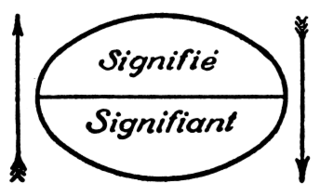
Ferdinand de Saussure was a Swiss linguist, semiotician and philosopher. His ideas laid a foundation for many significant developments in both linguistics and semiotics in the 20th century. He is widely considered one of the founders of 20th-century linguistics and one of two major founders of semiotics, or semiology, as Saussure called it.

Structuralism is an intellectual current and methodological approach, primarily in the social sciences, that interprets elements of human culture by way of their relationship to a broader system. It works to uncover the structural patterns that underlie all the things that humans do, think, perceive, and feel.

A sign is an object, quality, event, or entity whose presence or occurrence indicates the probable presence or occurrence of something else. A natural sign bears a causal relation to its object—for instance, thunder is a sign of storm, or medical symptoms a sign of disease. A conventional sign signifies by agreement, as a full stop signifies the end of a sentence; similarly the words and expressions of a language, as well as bodily gestures, can be regarded as signs, expressing particular meanings. The physical objects most commonly referred to as signs generally inform or instruct using written text, symbols, pictures or a combination of these.
Semiotics is the systematic study of sign processes (semiosis) and meaning-making. Semiosis is any activity, conduct, or process that involves signs, where a sign is defined as anything that communicates something, usually called a meaning, to the sign's interpreter. The meaning can be intentional, such as a word uttered with a specific meaning; or unintentional, such as a symptom being a sign of a particular medical condition. Signs can also communicate feelings and may communicate internally or through any of the senses: visual, auditory, tactile, olfactory, or gustatory (taste). Contemporary semiotics is a branch of science that studies meaning-making and various types of knowledge.
African-American English is the set of English sociolects spoken by most Black people in the United States and many in Canada; most commonly, it refers to a dialect continuum ranging from African-American Vernacular English to a more standard American English. Like all widely spoken language varieties, African-American English shows variation stylistically, generationally, geographically, in rural versus urban characteristics, in vernacular versus standard registers, etc. There has been a significant body of African-American literature and oral tradition for centuries.
In semiotics, a sign is anything that communicates a meaning that is not the sign itself to the interpreter of the sign. The meaning can be intentional, as when a word is uttered with a specific meaning, or unintentional, as when a symptom is taken as a sign of a particular medical condition. Signs can communicate through any of the senses, visual, auditory, tactile, olfactory, or taste.
Différance is a French term coined by Jacques Derrida. It is central to Derrida's concept of deconstruction, a critical outlook concerned with the relationship between text and meaning. The term différance means both "difference of meaning" and "deferral of meaning".
"Logocentrism" is a term coined by the German philosopher Ludwig Klages in the early 1900s. It refers to the tradition of Western science and philosophy that regards words and language as a fundamental expression of an external reality. It holds the logos as epistemologically superior and that there is an original, irreducible object which the logos represent. According to logocentrism, the logos is the ideal representation of the Platonic ideal.

Course in General Linguistics is a book compiled by Charles Bally and Albert Sechehaye from notes on lectures given by historical-comparative linguist Ferdinand de Saussure at the University of Geneva between 1906 and 1911. It was published in 1916, after Saussure's death, and is generally regarded as the starting point of structural linguistics, an approach to linguistics that was established in the first half of the 20th century by the Prague linguistic circle. One of Saussure's translators, Roy Harris, summarized Saussure's contribution to linguistics and the study of language in the following way:
Language is no longer regarded as peripheral to our grasp of the world we live in, but as central to it. Words are not mere vocal labels or communicational adjuncts superimposed upon an already given order of things. They are collective products of social interaction, essential instruments through which human beings constitute and articulate their world. This typically twentieth-century view of language has profoundly influenced developments throughout the whole range of human sciences. It is particularly marked in linguistics, philosophy, psychology, sociology and anthropology.
In semiotics, the value of a sign depends on its position and relations in the system of signification and upon the particular codes being used.

Representation is the use of signs that stand in for and take the place of something else. It is through representation that people organize the world and reality through the act of naming its elements. Signs are arranged in order to form semantic constructions and express relations.

A literary trope is the use of figurative language, via word, phrase or an image, for artistic effect such as using a figure of speech. Keith and Lundburg describe a trope as "a substitution of a word or phrase by a less literal word or phrase." The word trope has also undergone a semantic change and now also describes commonly recurring or overused literary and rhetorical devices, motifs or clichés in creative works. Literary tropes span almost every category of writing, such as poetry, film, plays, and video games.
Diaspora literacy is a phrase coined by literary scholar Vévé Clark in her work "Developing Diaspora Literacy and Marasa Consciousness". It is the ability to understand and/or interpret the multi-layered meanings of stories, words, and other folk sayings within any given community of the African diaspora. These meanings supersede those of "...Western or westernized signification" (42), meaning that they go beyond literal or typical literary interpretation into an area of folk understanding that could only be recognized by the eye skilled in such an understanding. Readers rely solely upon a knowledge and lived experience of social, historical, and cultural climates of the various cultures of the African diaspora as a foundation for interpretation.
The Signifying Monkey: A Theory of Afro-American Literary Criticism is a work of literary criticism and theory by the American scholar Henry Louis Gates Jr. first published in 1988. The book traces the folkloric origins of the African-American cultural practice of "signifying" and uses the concept of signifyin(g) to analyze the interplay between texts of prominent African-American writers, specifically Richard Wright, Ralph Ellison, Zora Neale Hurston and Ishmael Reed.
Social semiotics is a branch of the field of semiotics which investigates human signifying practices in specific social and cultural circumstances, and which tries to explain meaning-making as a social practice. Semiotics, as originally defined by Ferdinand de Saussure, is "the science of the life of signs in society". Social semiotics expands on Saussure's founding insights by exploring the implications of the fact that the "codes" of language and communication are formed by social processes. The crucial implication here is that meanings and semiotic systems are shaped by relations of power, and that as power shifts in society, our languages and other systems of socially accepted meanings can and do change.
Structural linguistics, or structuralism, in linguistics, denotes schools or theories in which language is conceived as a self-contained, self-regulating semiotic system whose elements are defined by their relationship to other elements within the system. It is derived from the work of Swiss linguist Ferdinand de Saussure and is part of the overall approach of structuralism. Saussure's Course in General Linguistics, published posthumously in 1916, stressed examining language as a dynamic system of interconnected units. Saussure is also known for introducing several basic dimensions of semiotic analysis that are still important today. Two of these are his key methods of syntagmatic and paradigmatic analysis, which define units syntactically and lexically, respectively, according to their contrast with the other units in the system.
The signifying monkey is a character of African-American folklore that derives from the trickster figure of Yoruba mythology, Esu Elegbara. This character was transported with Africans to the Americas under the names of Exu, Echu-Elegua, Papa Legba, and Papa Le Bas. Esu and his variants all serve as messengers who mediated between the gods and men by means of tricks. The signifying monkey is "distinctly Afro-American" but is thought to derive from Yoruban mythology, which depicts Echu-Elegua with a monkey at his side.

Signifying Rappers: Rap and Race in the Urban Present is a nonfiction book by Mark Costello and David Foster Wallace. The book explores the music genre's history as it intersected with historical events, either locally and unique to Boston, or in larger cultural or historical contexts.

In semiotics, signified and signifier are the two main components of a sign, where signified is what the sign represents or refers to, known as the "plane of content", and signifier which is the "plane of expression" or the observable aspects of the sign itself. The idea was first proposed in the work of Swiss linguist Ferdinand de Saussure, one of the two founders of semiotics.
Charles Houston Long was an African-American cultural historian, religious studies scholar, and essayist in the areas of religion, theology, philosophy and studies of modernity. He was a faculty member at the University of Chicago, UNC Chapel Hill, Syracuse University, Duke University, and UC Santa Barbara. His work built on Ferdinand de Saussure's semiotics. Significations in particular is about how the West gets to make meaning about other cultures, but those cultures don't get the opportunity to make meaning about themselves.








